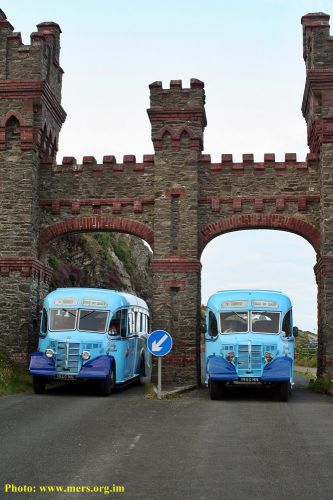Last Thursday, July 23, 2015 the Manx Electric Railway Society, with the kind help of Tours Isle of Man, the Island's coach operator staged a tour of former Manx tramway systems using Tours two 1950's vintage Duple Vista bodied Bedford OB coaches. In addition a short ride around the Baldwins featured re-creating, in part, a regular haunt for this type of coach when they were in abundance on the Island. With the scheduled retirement of these two coaches during this year, this would be one of the last opportunities to see and travel on board the pair together.
Leaving Hill Street shortly after 7.30pm, the Bedfords called at Douglas Sea Terminal for others to board, before negotiating the climb up Head Road towards Douglas Head, site of the northern terminus of the Douglas Head Marine Drive Tramway, and where background views of Douglas Bay can be seen to best advantage. Dry weather afforded photographers the opportunity to exercise their cameras at this location, as it would in several other places throughout the evening.
Hugging the coastal rocks southwards towards Port Soderick the Douglas Southern (later Douglas Head Marine Drive) Tramway was constructed in 1896 carrying hundreds of thousands of holidaymakers bound for a day out at the facilities once offered at Port Soderick cove, affording unrivaled coastal views from a fleet of sixteen open-top double-deck tramcars along and over some spectacular engineering works. Temporarily closing for the duration of the Great War, the line re-opened in 1919, continuing until the outbreak of World War II, but would never run again. All bar one tramcar would be scrapped, the sole surviving car now resides on static display at the Crich tram museum in Derbyshire. During the 1960's the Marine Drive route was revamped as a roadway, with many bridges removed as rock was cut away to bypass their need. Coastal erosion has since resulted in a section of roadway being closed to vehicular traffic, although it remains negotiable by pedestrians.
From Douglas Head the OB's began their 'tramway' excursion over the open northern section of the Marine Drive Tramway route, passing under the entrance gates and on to the furthest possible turning point. With the tramway etched into distant rocks the coaches returned to Douglas Head, down Head Road and using inland highways passed the Isle of Man Steam Railway line at Oakhill before reaching Keristal, where the tramway route was re-joined, from the southern end. Northwards from here is where the most impressive remaining engineering can be viewed, on ledges cut into sheer rock faces, and a real taste of what the line was once like is glimpsed. Little Ness, site of the former tramway depot buildings, is the furthest point north that can be reached from the southern end before the highway is blocked, the coaches heading for that location to turn before returning to Keristal and leaving this tramway.
Over busy mains roads to Strang and onward to Mount Rule where, turning right, the narrow lanes around Baldwin began. Climbing the incline from Mount Rule mountainous vistas unfolded, before the decent into West Baldwin village. Through the village and onwards to the edge of Injebreck reservoir - where after a particularly dry period it is sometime possible to see the remains of buildings flooded during construction - when, crossing the valley, the long climb hugging the valley's eastern side to St. Luke's Church was undertaken. Pausing again for photographers, the coaches were soon on their way down the very steep hill towards the East Baldwin road, continuing through the small hamlet, St. George's Bridge and Abbeylands Crossroads before returning to Douglas Harris Promenade.
Darkness was descending on the climb up Broadway, Stanley View, York Road to Avondale, by now over the route of the former Douglas Cable Tramway. For thirty-three years between 1896 and 1929 the tramway was the prime move of residents/holidaymakers from downtown Douglas to, when it was first constructed, the very edge of Douglas. Similar to the Douglas Head Marine Drive Tramway, the majority of Douglas cable trams were scrapped after the system as abandoned, although two found a new use as a dwelling at Jurby on the Island's northern plain. Subsequently these two cars would be rescued for restoration, forming one car, 72/73, currently on display at the Jurby Transport Museum. Turning left at Avondale the Cable Tramway route was followed down Woodbourne Road, Prospect Terrace, Buck's Road, Prospect Hill and Victoria Street to the end of the line at the Jubilee Clock - recently moved slightly from its original location.
Arriving back at Douglas Sea Terminal and then Hill Street, the evening tour drew to a close, after almost three hours of pure nostalgia. Not only did those on board take the opportunity of traveling on board the attractive, comfortable vehicles of yesteryear and re-visit sites of Manx tramway interest, they also received a complimentary fact sheet/flyer and an original 1950's Villa Marina to Port Soderick bus ticket.
Without the valuable assistance and support of Tours Isle of Man and its staff it would not have been possible to undertake the tour for which the Manx Electric Railway Society is most grateful. The Bedford OB coaches are ideal for wedding parties, corporate hire, enthusiast & other groups and remain available for hire before retirement. For further details, availability, etc please contact Tours Isle of Man Limited, 4 Akerman Court, Balthane Estate, Ballasalla, Isle of Man, IM9 2AJ, Tel: 01624 822611, Email: [email protected] Website http://www.toursisleofman.co.uk/
Getting ready for the off in Hill Street, Douglas
At Douglas Sea Terminal
Douglas Head with the Bay forming the backdrop
On the Marine Drive with background rock face
Pausing at St Luke's Church on the Baldwins excursion
Back at home - at the end of the evening
